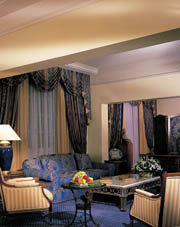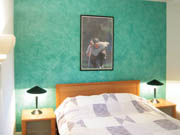
"Imagine a building product coming from a raw material that is naturally occurring, abundant, healthy, noncombustible and that can readily be dehydrated and rehydrated to become a hard, durable, paintable surface. Then imagine after four thousand years of use worldwide with little change-and plenty of examples of applications still in place and sound after centuries or even millennia of use-the material is almost entirely phased out over a span of just 20 years. Finally, imagine that in just 20 more years, the replacement product's primary advantages (speed and ease of application) become its most widely cited weaknesses. No need to pinch yourself. Welcome to the real world of plaster and gypsum board."
- "Interior Finish Systems: Judging a Building by its Inside Cover," from Environmental Building News, Nov. 2000.

I know firsthand coming from a third-generation plastering family, that plasterers are an unusual breed of people-sometimes arrogant, defiant and unrealistic but always hardworking and talented. Think about it: Who would choose to be a plasterer in today's society? To the onlooker, the work is hard and dirty with little reward. This was the question I faced during my early years in business by friends in college. They could not imagine why I chose to stay in the plastering business. Of course, my family owned a respected and successful plastering business that started in 1949 (when interior plaster dominated) and most felt it was due to some family duty to pursue this path and continue tradition.

Satisfaction guaranteed
However, there is something about plastering that few people can understand: the creative and satisfying feeling one gets while plastering. Artists certainly have the creative feeling side as they admire their work but they would not experience the physical demands on their body that plastering requires. A tile setter or carpenter can feel pride from creative work and feel the physical demands. I can and have framed, set tile and have done most trades with little or no difficulty.To become skilled and proficient at interior plastering takes time to learn and cannot be learned from reading a book or merely by watching others. One has to get in and do it over and over again, with a mentor fixing mistakes as one suffers sore muscles all the way. The trade of interior plastering is tough to learn and teach; this is widely accepted as the most significant downfall of the plaster industry.
There is another factor in the interior plaster market that has contributed to its downfall: marketing. Most plasterers do not have a clue what it means and how it affects their business. I would think that most have felt they tried marketing their plaster business by putting an advertisement in the local paper or Yellow Pages. The first step is to think about what opportunities are out there and how the market may have changed, and how one can make the most of it.
Plaster Man has written some good articles to help us think about how to market our product and think outside the box. The Venetian plaster manufacturers have also made some good progress in the arena of upscale homes and commercial work. There may be another untapped market that few if any in the plastering businesses are looking seriously at.

What's considered new is old
It would not be hard to notice all the home improvement shows that are so popular on television. "This Old House" has morphed into countless numbers of similar shows and if the crowds in large home improvement are any indication, there is a lot of home improvement going on today. Market surveys also seem to point to the trend to continue for years to come. Consider this: There are hundreds of thousands of homes with heavy drywall textures and acoustical ceilings that people desperately want to change. I know because the Northwest Wall and Ceiling Bureau gets calls from the public on a fairly regular basis on what to do about the "popcorn" ceilings and other textures. Many of these homes were built as affordable homes but after 30 to 40 years, can be classified as upper-middle class and owners want to bring the home up to these standards.Both of my last two homes were built in the '70s with the heavy knockdown texture and acoustical ceilings. For these, I chose an integrally colored veneer plaster to transform the heavy texture and dirty popcorn ceilings to semi-smooth, colored plaster walls with warmth and character. Our realtor coined the phrase "pottery barn," like walls on the flyer to sell our home. During the open house, she said the interior plaster was well received and was one of the major factors for the new owners to buy the home.
The process of applying colored veneer plaster over textured drywall can be done at one time with a scratch and double coat in a variety of pastel colors. The result is a semi-smooth texture with a depth of color that faux painting can only imitate. I became much faster as I worked more with the product and learn the subtle traits of the material. I began to think how I would have used my plaster crew for remodels of homes done with heavy textures.
The use of Venetian plaster was perfect for some accent walls. This is also perfect winter work in areas where outside plastering can be difficult. The process can move along fairly fast as crews become more familiar with the product and create a system. Even for walls that are to be painted, veneer plaster is a perfect choice. A skim coat of joint compound will require more than one pass with additional time between coats and sanding. Minor touchups can be done with an all-purpose joint compound (I would not recommend touching up with topping muds, as they have less glue and adhesion can be a problem).
While marketing interior colored veneer plaster may seem like the natural process of the material manufacturer and dealers, it really relies more upon the plastering contractor. These materials are relatively inexpensive and the profit for the manufacturer and dealer is not near what it is for the plastering contractor. In addition, the manufacturers and dealers still sell products if homeowners decide to use a joint compound and paint. The transformation of a home from traditional 1975 textured drywall to a colored veneer plaster and some Venetian plaster adds value and warmth to a home. This does not even take into account the new pre-manufactured crown moldings and chair rails that are now offered by most dealers.

Report Abusive Comment